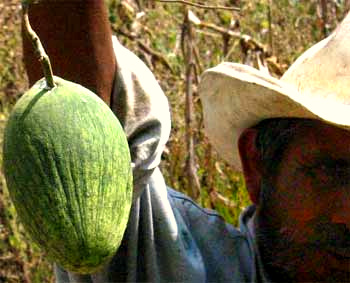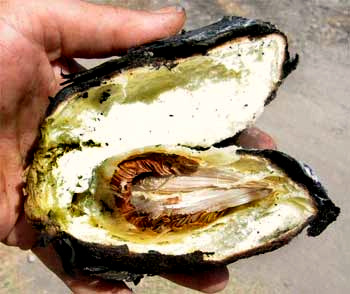Excerpts from Jim Conrad's
Naturalist Newsletter
from the February 25, 2008 Newsletter written in the community of 28 de Junio, in the Central Valley 8 kms west of Pujiltic, elev. ~700m (2300ft), ~N16.331°, ~W92.472°; southeastern Chiapas state, MÉXICO
EATING CLIMBING MILKWEED
 Especially now during the dry season when many trees are leafless often you see asymmetrically ovate fruits the size of grapefruits dangling from slender, dried- up, leafless vine stems tangled in the outer branches of trees ten or fifteen feet off the ground. One is shown at the right. In a few weeks these pods will open and release into the wind dozens of flat, lentil-size seeds equipped with fuzzy, white parachutes.
Especially now during the dry season when many trees are leafless often you see asymmetrically ovate fruits the size of grapefruits dangling from slender, dried- up, leafless vine stems tangled in the outer branches of trees ten or fifteen feet off the ground. One is shown at the right. In a few weeks these pods will open and release into the wind dozens of flat, lentil-size seeds equipped with fuzzy, white parachutes.
I've read that young milkweed shoots can be cooked and eaten. Actually I've tried them, but found the leaves too bitter and fuzzy to fool with. I'm a bit hesitant to eat anything in the Milkweed Family because the white latex they produce so abundantly when injured contains powerful chemicals, alkaloids I suppose.
Therefore I was intrigued the other day when a local farmer pointed out a "Climbing Milkweed" fruit pod dangling from a tree and said that they weren't bad to eat. That's the farmer and his collected pod atop this page.
Collecting some pods was a messy process because they issue white, very sticky latex from the merest injury. The latex turns black on your hands and your fingers get gummy.
Per instructions, the next morning I roasted the pod in my campfire's embers as my breakfast stew happily bubbled away. The pod's thin skin charred black but the interior remained white, as shown below:

Inside the pod I found two things to eat. First were the seeds, which in the pictures are the brown, scaly things packed atop one another. The seeds' future fuzz parachutes will arise from the white, slender items lying horizontally to the right of the seeds. The future fuzz was too hard and stiff to consider eating. The seeds didn't have much taste at all, only a slight bitterness, but they left a certain fungusy, not unpleasant aftertaste. I'll bet they provided some protein, though.
Most of the pod's eating is offered by the white, spongy material surrounding the seed/parachute chamber, and you can see that there's plenty of that. This material definitely tasted fungusy, and even had the texture of a mature mushroom cap.
Actually, it wasn't bad. I can imagine that with a little salt, pepper and maybe some butter -- preparing it as you might a good mushroom -- it could be quite good.
However, I like how parachuted milkweed seeds launch from their pods, and I like seeing the milkweeds' unusual, very pretty flowers with special adaptations for their sophisticated pollination system, so I'd rather just let the vines be, and forego any modest meal of fungusy-tasting pod goo.